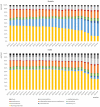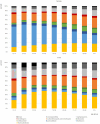Prescription of antibiotics for urinary tract infections in outpatient care in Bavaria: An analysis of routine data
- PMID: 39453905
- PMCID: PMC11508671
- DOI: 10.1371/journal.pone.0312620
Prescription of antibiotics for urinary tract infections in outpatient care in Bavaria: An analysis of routine data
Abstract
Background: Patients with urinary tract infection (UTI) in German outpatient care are usually treated by general practitioners (GPs), as well as by other specialties. To prevent antibiotic resistances and side effects, German guidelines recommend fosfomycin, nitrofurantoin, pivmecillinam and nitroxoline as first-line treatments, and advice against broad-spectrum antibiotics such as fluoroquinolones and cephalosporins. However, data from the European Centre for Disease Prevention and Control indicates a significant proportion of second-line antibiotics in German outpatient care. Our aim was to analyze whether antibiotic prescription has changed over time in accordance with guidelines. In addition, we aimed to investigate whether specialties prescribe different antibiotics for UTIs and whether prescription varies according to patient age and sex. For patients receiving more than one antibiotic, we wanted to determine whether subsequent prescriptions show a change in substances and specialties involved.
Methods: This retrospective study involved routine data (2013 to 2019) provided by the Bavarian Association of Statutory Health Insurance Physicians. Data on diagnoses and prescriptions were transmitted from outpatient care physicians on a quarterly basis. UTI patients ≥12 years were included.
Results: We analyzed 1.7 million UTI prescription cases. In females, shares of fluoroquinolones decreased sharply over time, while shares of first-line substances fosfomycin and pivmecillinam increased. Gynecologists showed the highest shares of first-line substances compared to GPs and urologists. Fluoroquinolone shares decreased in all three specialty groups. In females, older patients showed lower shares of first-line substances than younger patients. If a second or third antibiotic was prescribed, fosfomycin shares decreased, while shares of nitrofurantoin, nitroxoline and cephalosporins increased.
Conclusions: Our findings show a trend towards a more guideline-adherent prescribing in the treatment of UTI, with a significant increase of shares of fosfomycin and pivmecillinam, especially in women, and a sharp decrease of shares of fluoroquinolones.
Copyright: © 2024 Hanslmeier et al. This is an open access article distributed under the terms of the Creative Commons Attribution License, which permits unrestricted use, distribution, and reproduction in any medium, provided the original author and source are credited.
Conflict of interest statement
The authors have declared that no competing interests exist.
Figures




References
-
- Foxman B, Barlow R, D’Arcy H, Gillespie B, Sobel JD. Urinary Tract Infection. Annals of epidemiology 2000;10(8):509–15. - PubMed
-
- Simic D, Wilm S, Redaèlli M. Germany. In: Kringos DS, Boerma WG, Hutchinson A, Saltman RB, editors. Building Primary Care in a Changing Europe: Case Studies. Geneva, Herndon: World Health Organization; Stylus Publishing, LLC [distributor]; 2015. p. 89–98.
-
- Malmros K, Huttner BD, McNulty C, Rodríguez-Baño J, Pulcini C, Tängdén T. Comparison of antibiotic treatment guidelines for urinary tract infections in 15 European countries: Results of an online survey. Int J Antimicrob Agents 2019;54(4):478–86. doi: 10.1016/j.ijantimicag.2019.06.015 . - DOI - PubMed
MeSH terms
Substances
LinkOut - more resources
Full Text Sources
Medical

